RIGHT TURN ONLY!!
And the Gunslinger Followed
by Carlo Santos,

I'm sure everyone is already sick of hearing about that convention. Anyway, it's time to concern ourselves with the one where Viz, Tokyopop and Del Rey will at least bother to put up a booth.
Onward! To Comic-Con!
DRAGON EYE
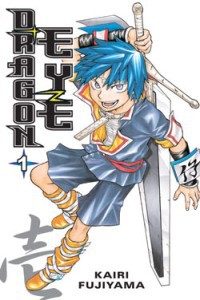
Vol. 1
(by Kairi Fujiyama, Del Rey, $10.95)
FROM THE BACK COVER:
"Ten years ago, a terrible virus swept the globe. It turned its victims into bloodthirsty monsters called Dracules, and the only cure is death. Now, with humankind on the brink of extinction, only the elite warriors of the VIUS Squad stand between chaos and civilization. New recruit Leila Mikami is one of the squad's most promising young warriors, but she has another agenda: Her parents were killed by a Dracule, and she's determined to take revenge. To do this, she has to find the Dragon Eye—a magical weapon that will make her the most powerful warrior in the world."
EVIDENCE FOR:
Do you want to see something fantastic? Then just flip to any page in this volume, which is absolutely bristling with dynamic art and bold lines. It's like Kairi Fujiyama's pen was so choked up with energy that it had to let itself out as a wild action-adventure series, for fear that it might explode as a giant globule of very expensive ink. Here's an artist who's unafraid of a challenge, using tricky angles and distorted perspective to turn every action scene into a thrill ride. That same feeling comes from the pacing of the story itself, which moves at a speedy clip and avoids unwanted fluff—when these people say they're going monster hunting, they're going monster hunting, dammit, and they make sure not to leave the chapter without a fight. Humorous characters also make it fun, with flaky squad captain Issa leading the way and brash, by-the-book Leila right there to keep him in line. If you want the definition of swashbuckling, this is it.
EVIDENCE AGAINST:
Fantasy titles with the word "dragon" in them are not to be trusted ... and this one is no different. Dragon Eye seemingly rips off everything ever made: a worldwide apocalyptic virus, an elite fighting organization, adventurers in search of vengenace, and of course, nasty monsters in need of extermination. Heck, even the name "Dracule" is pretty unimaginative—if you're going to come up with a special word for the enemy, at least put some effort into it. Not surprisingly, the story soon locks into a generic mission format; it tries to introduce some charatcer history through flashbacks but is clearly more interested in having awesome warriors fight fearsome monsters. But neither party looks all that awesome or fearsome—the main characters suffer from squat, childlike designs and piecemeal fantasy outfits, and the monsters more comical than monstrous (witness the giant chicken in the third chapter. A giant chicken? Honestly).
RTO!! RATING:
It should be no surprise that yet another sprightly adventure series is marred by completely average execution. And in this world, average means C.
GUNSLINGER GIRL
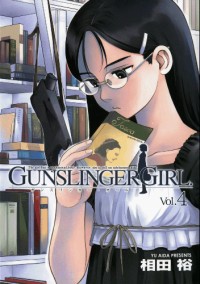
Vol. 4
(by Yu Aida, ADV Manga, $9.99)
FROM THE BACK COVER:
"Though brainwashed to be cold-blooded killers, the child assassins of Section Two continue to develop beyond the range of their 'conditioning.' Claes struggles with tears that never come, while Henrietta must deal with her growing feelings for her handler Giuseppe. But there's still hope in Triela, who's slowly coming to terms with her defeat at the hands of Pinocchio ... and remembering the girl she once was."
EVIDENCE FOR:
It may seem oxymoronic to call Gunslinger Girl a laid-back action series, but that's exactly what makes it unique. Continental elegance and crime-fighting brutality go hand in hand in this volume, which goes from one extreme (an idyllic day in Claes's life) to the other (the disturbing past of Triela's handler Hartmann) over the span of 180 pages. It's a contrast that's reflected in the art as well, where clean lines and stylish designs often share space with bloody killings and frantic action. Yet it's not the violence that makes the series intense, but the strained relationships between the girls and their handlers. No amount of blood and guts could ever match the emotional weight of what Hartmann had to bear in his early years; even the lighter stories with a low body count are infused with a thoughtful sadness. After all, these girls are walking experiments who have had their humanity robbed—and that, perhaps, is the ultimate tragedy.
EVIDENCE AGAINST:
Laid-back is exactly what's wrong with this series. The story is all over the place, with only the loosest of threads to tie it together—recurring characters, an ongoing fight against the Mob, and the girls' emotional issues. The chapters might as well be stand-alone, the way they jump from character to character and never establish a definite focus. Are we supposed to care most about Henrietta? Or is Triela the big story of the day? Just pick one direction and go with it! And when it does decide to finally start going somewhere, the steps are completely off-pace—30 pages of talking and prepping for the mission, and then maybe 3 pages of actual combat. Say what you want about the emotion overshadowing the action, but when a series has the word "gunslinger" in the title, I expect to see more guns being slung.
FINAL VERDICT:
The titular characters may have flawless marksmanship with a gun, but this volume is decidedly hit-or-miss, averaging out to a B-.

Vol. 3
(by Housui Yamazaki, Dark Horse, $10.95)
FROM THE BACK COVER:
"Haunted cell phones, hotel rooms of horror, and the drowned dead are all laid to rest as Mail concludes with Detective Akiba taking a trip down memory lane—the dark path of his blind youth, when he befriended a little girl in the woods, not knowing that he would one day see her—again, and under very different circumstances!"
EVIDENCE FOR:
I hereby crown Housui Yamazaki the king of layouts (men's manga division). Few artists can beat him when it comes to spacing and timing—every pregnant pause, every silent panel, every dramatic reveal adds up to a good old scare even though everyone already knows what the series is about. The first chapter and a half are the most ambitious in this volume, digging into Akiba's past and presenting the flashback in grainy white-on-black negative. In the hands of a lesser artist, this would have become a complete mess—but with Yamazaki holding the pencil, it's a story as clear and haunting as all the rest. Akiba also comes out of it with a creepy re-animated sidekick, which probably counts as the first time a new character has been added to the cast. The remaining stories fall into the more traditional investigate-solve-and-exorcise formula of the series, but they still evoke that urban-legend atmosphere that makes each case so fascinating. Little everyday mysteries draw you deeper and deeper into this world until, finally, Akiba lets that bullet go ... and you realize, once again, that this is some of the best supernatural storytelling there is.
EVIDENCE AGAINST:
When was the last time a volume of a reasonably good series actually got worse as it progressed? Reading this is like being subjected to the "it gets better" principle in reverse, where a really stunning, mind-bending first chapter leads to weaker and weaker work until finally it concludes with the most generic of plot ideas: a bunch of kids experiencing a real-life haunting after playing in an abandoned building. What the heck, people, wasn't that the first volume of Ghost Hunt? It's a disappointing finish to a series that was otherwise pretty consistent from story to story. And perhaps that consistency is also what held it back—once again Akiba's investigations rely on his ridiculous bullet-firing catchphrase, and his Twilight Zone-esque introductions to each case, and the fact that his clients are always young women in distress. Any single one of these chapters is a winner—as Yamazaki's masterful storytelling proves—but string a bunch of them in a row, and it starts to look like repetitive gimmickry from an artist who must think he's so good he doesn't need to challenge himself.
FINAL VERDICT:
Repetitiveness be damned—this is one series that always delivers a good helping of mystery and horror, even if it's not the most creative. From reading ... to reviewing ... to B.
MAMOTTE! LOLLIPOP
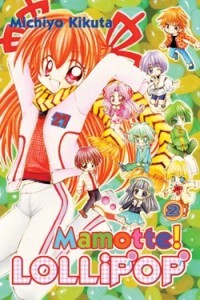
Vol. 2
(by Michiyo Kikuta, Del Rey, $10.95)
FROM THE BACK COVER:
"Nina doesn't have just one dream boy—she has two: Zero and Ichi. Both are supercute wizards who make her heart beat a little bit faster. But which boy is Nina actually falling for? When a second pair of wizards arrives from the Magical World, Nina learns a little bit more about Zero and Ichi's mysterious past, and why they're so intent on passing the Magic Exam at the wizards' academy. And faster than you can say 'taffy pull,' Nina finds herself caught in a tug-of-war between Zero and Ichi!"
EVIDENCE FOR:
"It gets better" is a relative term. The latest Mamotte! Lollipop may not be entering masterpiece territory anytime soon, but it's showing signs of trending upward, especially with the last two chapters flashing back to when Zero and Ichi met. It's good, serious stuff that reveals more about the characters and proves to be more satisfying than the schoolyard hijinks so far. But speaking of hijinks, the sense of humor is improving as well, with some well-executed gags: 4 Ways To Exorcise People Dressed Up As Ghosts, and a body-switch that leads to personality goofs galore. Character designs are still bright and appealing, and the layouts—busy as they are—never get in the way of the story flow. You'll even get a dramatic pause or two, showing that the series is headed ... well, somewhere. And don't miss the one-shot story in the back with its whimsical fantasy romance that blends historical China and Kamikaze Kaitou Jeanne (I kid you not).
EVIDENCE AGAINST:
Despite a serious flashback, the series still feels too light and fluffy most of the time, like it's afraid of digging into the real challenges facing the Magical World examinees and Nina's involvement with them. After all, the middle-school happy-fun-time chapters still outnumber the serious development chapters. And even then, a mediocre art style dominates—most of the secondary characters (how many are there? Five?) are indistinguishable if not for their outfits; there's just too big of a supporting cast and not enough face time for them. Backgrounds are a rush job as well, relying on generic school and city settings and covering up blank areas with tones and patterns. When the artist has to admit to her own faults in the marginal notes ("Oops! Background character looks too much like Ichi!"), that just makes it easier to spot the shortcomings.
FINAL VERDICT:
The story's going somewhere, so it is getting better—but only in the sense that a C is better than, what was it last time, D?
STRAWBERRY 100%
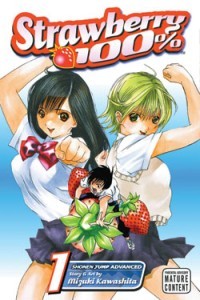
Vol. 1
(by Mizuki Kawashita, Viz Media, $7.99)
FROM THE BACK COVER:
"EXT. ROOFTOP OF A SCHOOL BUILDING. SUNSET
The hero (me, Junpei Manaka!) sneaks up to the roof to see the sunset. When he opens the door, he startles a mysterious beauty. She panics and runs away, but not before Junpei has caught sight of her adorable strawberry print panties ... in EXTREME close-up. With that vision forever burned into his memory, Junpei embarks on a quest to find the girl, and the panties, of his dreams!
FADE OUT"
EVIDENCE FOR:
How's this for innovation: an entire manga series predicated on a fabric pattern. Strawberry 100% wastes no time in sending Junpei on his quest for the elusive girl with strawberry panties; by the end of Chapter 1 he's already asked out school hottie Tsukasa Nishino and harboring confused feelings over bookish Aya Tojo. At the same time, though, the characters also try to go beyond the formula of their prescribed love polygon. Junpei may seem like the typical hapless male lead, but he also wants to be a filmmaker, which is pretty admirable. Aya isn't just the nerd who's secretly hot, but has creative ambitions that resound with Junpei's. But character development can wait, as this volume focuses on the comedy. Junpei's goof over Tsukasa's cell phone number leads to a brilliant chain reaction of gags and comedic set-ups—lies and misunderstandings snowballing from one chapter to the next. And of course, something must be said about the cute character designs—the girls can definitely turn on the charm at will, and the better-looking of Junpei's male buddies even has a touch of bishounen in him.
EVIDENCE AGAINST:
Despite the—ahem—interesting starting point, the story quickly descends into typical boys' romance fodder. Will the lucky guy pick the hot girl or the smart girl?—A question that's been asked within the pages of the comics for decades. Another drawback is the lack of fanservice-laden, raunchy humor of other similar titles (I know, I criticize other series for having too much fanservice, but I guess you don't really miss something until it's gone). Panty and cleavage count are surprisingly low, as it's got to be safe enough for little boys to flip through when they pick up their copies of Shonen Jump. And that lack of risqué comedy leads to the next problem—over-reliance on dull sitcom setups like getting stuck in a broom closet. Come on, where's the creative spark? Also beware the girls' haunting dead-eyed stares ... apparently they're cute close up, but stand more than ten feet away and they look like those creepy so-real-they're-fake love dolls. Yikes!
FINAL VERDICT:
While it has some good points, this is basically looking like a "starter harem" series. Boy meets girls, boy must choose between girls, repeat as needed to earn a C.

HATARAKI MAN
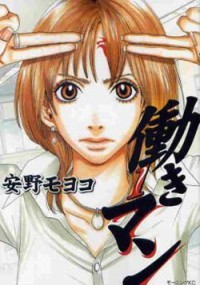
Vol. 1
(by Moyoco Anno, Kodansha, ¥514)
FROM THE ENCYCLOPEDIA:
"Hiroko Matsukata is a woman who works for a magazine company. She puts all she has into her work, and is known as a strong, straight-forward working girl, who can at will turn herself into Hataraki man (working man) mode. Despite Hiroko's success at work, her life lacks romance. Even though a hard worker, she'd leave early anytime to go on a date. Too bad her boyfriend is even bigger a workaholic than Hiroko."
EVIDENCE FOR:
Anno's tales of the working world strike a remarkable balance between snarky and sentimental. One moment she's tearing up the journalism industry for its nasty little habits—political spin, gossip-mongering, friction in the workplace—and next she's reflecting on the personal triumphs that make Matsukata's job worth it. The fun part is meeting all the characters and seeing your own friends and colleagues reflected in them: Matsukata is the incurable workaholic, of course, but there's also the self-assured hothead who can't get things right, the eccentric lazy guy who somehow always does his job, the bright-eyed bushy-tailed newcomer, and many others. Everyone feels so real that they pop right off the page—and that's true in a visual sense as well, with everyone having a distinctive look that suits their personality. Sure, it's not as florid as Anno's work on Sugar Sugar Rune, but the talent is definitely there, with lively lines and snappy layouts that welcome readers to a world of high risk and high reward.
EVIDENCE AGAINST:
Somewhere, someone is having a fit of self-righteous anger because of the sexist subtext where Matsukata powers up by "turning into a working man." That's not the point. It's a metaphor for entering a zone of heightened mental focus, but no, someone's going to read it the wrong way because EVERYTHING has to be about boys vs. girls. (It's not even a plot point anymore after the first three chapters...) And funnily enough, mental focus seems to be the one thing that's missing from the early chapters—storylines jump haphazardly from scene to scene, not knowing which way the plot is headed. Clearly, Anno had to spend a little time figuring out where she wanted to go with this series. Then there's the marketability issue: these stories probably won't click with anyone below college age, so it'll be import-only for quite a while—at least until the US core manga audience grows up.
FINAL VERDICT:
Whether it's magical girls or working women, Moyoco Anno is always ready to weave fascinating stories, and top them off with stylish illustrations.
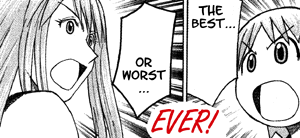
With Harry Potter month getting into full swing, we turn to the realms of teenage magic! One of the Best Manga I've Ever Read just happens to fall in that genre:
ULTRA MANIAC

Vols. 1-5
(by Wataru Yoshizumi, Viz Media, $8.99 each)
Every now and then, people ask for recommendations on a good short series. The perfect answer to that is Ultra Maniac: it's got romance, comedy, drama, mystery, fantasy, and coming-of-age all wrapped up into an incredibly satisfying 5 volumes.
The really amazing thing is how so much happens in just 5 volumes. The premise is deceptively simple, the kind that turns into generic mush in the hands of a lesser manga-ka: level-headed middle schooler Ayu has her life turned upside-down when loopy classmate Nina befriends her and says she's a witch from the Magic World. Nina is studying abroad on Earth so that she can brush up her spellcasting in a low-pressure, non-magical environment—but everytime she comes up with a spell to help Ayu, it backfires. The worst part is that most of these spells involve romance, which of course is hilariously awkward at that age: Ayu likes a guy named Tetsushi, while Tetsushi's friend Hiroki has his eye on Nina, but then Nina's childhood friend from the Magic World shows up, and ... anyway. Somehow, Yoshizumi is able to juggle at least 3 major relationships in the story (amidst other crushes, jealousies and deceptions), tie each one up satisfactorily by the end of the series, AND still have time for comedy hijinks (mostly Volumes 1 and 2), a detective-like mystery and a magical battle (Volumes 3-4), and Nina's own self-actualization (Volume 5).
And it's not like this is just some cheap, soap-operatic rollercoaster—the relationships are genuinely sweet and touching, in the way only first love can be. Look at the characters' expressions, their mannerisms, and the adorable things they say to each other. Behind the flowery, shoujo-mainstream art style is a command of pacing and emotion that will melt just about anyone—panels and pages line up perfectly for every dramatic moment, often expressing strong feelings without a single word. There are very few manga-ka who can turn pure emotion into pure art (Tanemura is often the first that comes to mind), and Yoshizumi is one of the masters of the technique.
I have heard that the anime version of this series is a lame, dumbed-down effort that focuses on the fantasy elements. (A flying scooter? Transformation sequences? Blah.) But the manga gets it right: spells and charms are fun, but the real magic lies in love, friendship, and being true to yourself.
discuss this in the forum (26 posts) |